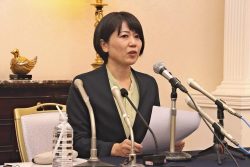
Mujirushi Ryohin 500 in Mitaka, Tokyo
12:00 JST, November 4, 2022
Hundred-yen shops, nicknamed hyakkin, are as popular as ever in Japan, and their rapid progress continues even in the face of the prolonged coronavirus pandemic.
According to a survey by Teikoku Databank Ltd., the four major hyakkin companies — Daiso Industries Co., Seria Co., Can Do Co. and Watts Co. — had 7,687 stores among them at the end of fiscal 2019. The number increased by 6.4% to about 8,400 stores at the end of February this year. The four companies have been opening over 100 stores each year without slowing down and are likely to be operating more than 10,000 stores in fiscal 2025.
Gross sales of the domestic ¥100-shop market in fiscal 2021 were expected to be ¥950 billion, an increase of 5.8% from the previous fiscal year. The ¥1 trillion mark is almost within its reach. While the increase in stores has certainly helped boost sales, the companies have also introduced their own originally developed high-performance products priced above ¥100, which has successfully raised average customer spending. There are also views that their growth has benefited from not having to hold bargain sales, the perennial nemesis of the fashion industry.
Taking note of the good run enjoyed by ¥100 shops, apparel makers are opening similar shops themselves. A good example is 3Coins, a ¥300-shop chain operated by Pal Group Holdings Co. 3Coins is very popular for a number of reasons. It stocks many trendy fashion items and seasonal products that are not available at ¥100 shops. It also recommends suitable items for women. And the staff can plan products that meet the detailed needs of some female customers.

This faux crocodile-skin smartphone case, a recent hit at 3Coins, is priced at ¥880.
That said, 3Coins is an established business — its first store opened in 1994 in Osaka. Now, the chain’s steady efforts are suddenly paying off, with 232 stores nationwide as of March 27. In the financial result for the business year ending February this year, 3Coins made ¥37.96 billion in net sales, up 46.2% from the previous year. This growth is attributed to meeting people’s needs while staying home during the pandemic. The brand has become a core part of Pal Group Holdings’ business, accounting for 28% of the company’s net sales of ¥134.2 billion in the February 2022 financial results.
The success of 3Coins inspired the launch of illusie300, another ¥300-shop chain that is doing well. It is run by clothing shop operator Palemo Holdings Co., which has changed its business model from apparel alone to having two arms: clothing and the ¥300 shop chain. The company now appears to be getting out of the red and moving into the black.
The apparel business may not be profitable, but the know-how gained seems to be useful in operating the one-price shop.
In fact, ¥300 shops sell some relatively expensive items. Among its recent top sellers are products for summer, such as hand-held fans and neck coolers, both priced at around ¥500 to ¥2,000, as well as smartwatches priced at around ¥2,000.
Yet another major company has joined the market with a ¥500-shop chain — Ryohin Keikaku Co., the operator of Mujirushi Ryohin, or Muji general stores. The company has launched Mujirushi Ryohin 500, which sells about 2,000 kinds of products priced at up to ¥500.
Its first store opened on Sept. 30 inside JR Mitaka Station in Mitaka, Tokyo. About 70% of the items sold at the shop are daily necessities and consumables costing less than ¥500. Now that price hikes are becoming an everyday affair, it is very enticing that one can purchase high-quality merchandise at a reasonable price.
And on Oct. 7, Mujirushi Ryohin 500’s first store in western Japan opened in the commercial complex Rosavia Ibaraki with direct access to Ibaraki-shi Station on Hankyu Railway’s Kyoto Line in Ibaraki, Osaka Prefecture. People line up in front of the store every day, which speaks volumes about its impact.
Why have these one-price shops caught on and become a fixture in Japan? It may be because one can buy essential items cheaply, something the pandemic has spurred in the past three years. However, my theory is that one-price shops allow people to satisfy their desire to consume, which is hard to satisfy elsewhere. Perhaps they are a modest playground for adults to let loose their impulse to buy since this desire has been suppressed by the long recession. I am starting to feel that one-price shops may be a curious by-product born from the depression of the Japanese economy over the past 30-plus years.
Some say when a market becomes ¥1 trillion in value and has 10,000 shops, it has reached its saturation point. Competition between one-price shops is becoming fierce, and the end is in sight for the pandemic, which boosted their growth. I will be very interested to see what the future holds for them.

Akira Miura
Miura is a journalist and a former editor in chief of WWD Japan.
"Culture" POPULAR ARTICLE
-

Van Cleef & Arpels Dazzles with Art Deco Artisanry at Tokyo Exhibit
-

Disney’s ‘Twisted-Wonderland’ Animated Series Puts Villains in Spotlight: New Show Features School Inspired by Classic Disney Films
-

Japan Plans to Distribute Manga Overseas Via New Platform
-

Japanese Craftsman Produces Beautiful and Durable Bags Made of Wood
-

Ayumi Hamasaki’s Shanghai Concert Canceled Day Before Schedule as Part of Beijing Backlash
JN ACCESS RANKING
-

Keidanren Chairman Yoshinobu Tsutsui Visits Kashiwazaki-Kariwa Nuclear Power Plant; Inspects New Emergency Safety System
-

Japan to Charge Foreigners More for Residence Permits, Looking to Align with Western Countries
-

Imports of Rare Earths from China Facing Delays, May Be Caused by Deterioration of Japan-China Relations
-

Japan Exports Rise in October as Slump in U.S. Sales Eases
-

Govt Aims to Expand NISA Program Lineup, Abolish Age Restriction

























